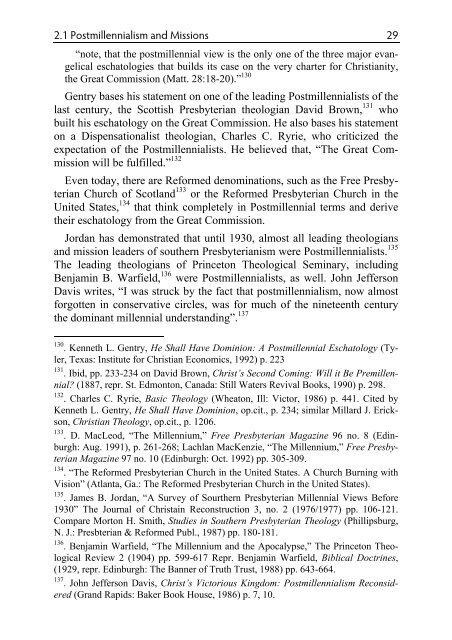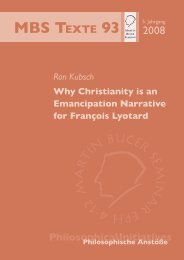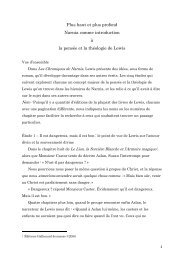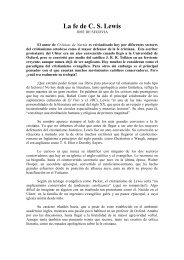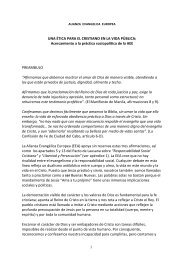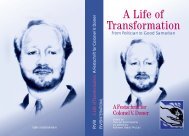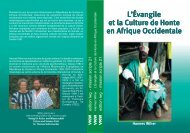William Careys Theology - World Evangelical Alliance
William Careys Theology - World Evangelical Alliance
William Careys Theology - World Evangelical Alliance
Create successful ePaper yourself
Turn your PDF publications into a flip-book with our unique Google optimized e-Paper software.
2.1 Postmillennialism and Missions 29<br />
“note, that the postmillennial view is the only one of the three major evangelical<br />
eschatologies that builds its case on the very charter for Christianity,<br />
the Great Commission (Matt. 28:18-20).” 130<br />
Gentry bases his statement on one of the leading Postmillennialists of the<br />
last century, the Scottish Presbyterian theologian David Brown, 131 who<br />
built his eschatology on the Great Commission. He also bases his statement<br />
on a Dispensationalist theologian, Charles C. Ryrie, who criticized the<br />
expectation of the Postmillennialists. He believed that, “The Great Commission<br />
will be fulfilled.” 132<br />
Even today, there are Reformed denominations, such as the Free Presbyterian<br />
Church of Scotland 133 or the Reformed Presbyterian Church in the<br />
United States, 134 that think completely in Postmillennial terms and derive<br />
their eschatology from the Great Commission.<br />
Jordan has demonstrated that until 1930, almost all leading theologians<br />
and mission leaders of southern Presbyterianism were Postmillennialists. 135<br />
The leading theologians of Princeton Theological Seminary, including<br />
Benjamin B. Warfield, 136 were Postmillennialists, as well. John Jefferson<br />
Davis writes, “I was struck by the fact that postmillennialism, now almost<br />
forgotten in conservative circles, was for much of the nineteenth century<br />
the dominant millennial understanding”. 137<br />
130 . Kenneth L. Gentry, He Shall Have Dominion: A Postmillennial Eschatology (Tyler,<br />
Texas: Institute for Christian Economics, 1992) p. 223<br />
131 . Ibid, pp. 233-234 on David Brown, Christ’s Second Coming: Will it Be Premillennial?<br />
(1887, repr. St. Edmonton, Canada: Still Waters Revival Books, 1990) p. 298.<br />
132 . Charles C. Ryrie, Basic <strong>Theology</strong> (Wheaton, Ill: Victor, 1986) p. 441. Cited by<br />
Kenneth L. Gentry, He Shall Have Dominion, op.cit., p. 234; similar Millard J. Erickson,<br />
Christian <strong>Theology</strong>, op.cit., p. 1206.<br />
133 . D. MacLeod, “The Millennium,” Free Presbyterian Magazine 96 no. 8 (Edinburgh:<br />
Aug. 1991), p. 261-268; Lachlan MacKenzie, “The Millennium,” Free Presbyterian<br />
Magazine 97 no. 10 (Edinburgh: Oct. 1992) pp. 305-309.<br />
134 . “The Reformed Presbyterian Church in the United States. A Church Burning with<br />
Vision” (Atlanta, Ga.: The Reformed Presbyterian Church in the United States).<br />
135 . James B. Jordan, “A Survey of Sourthern Presbyterian Millennial Views Before<br />
1930” The Journal of Christain Reconstruction 3, no. 2 (1976/1977) pp. 106-121.<br />
Compare Morton H. Smith, Studies in Southern Presbyterian <strong>Theology</strong> (Phillipsburg,<br />
N. J.: Presbterian & Reformed Publ., 1987) pp. 180-181.<br />
136 . Benjamin Warfield, “The Millennium and the Apocalypse,” The Princeton Theological<br />
Review 2 (1904) pp. 599-617 Repr. Benjamin Warfield, Biblical Doctrines,<br />
(1929, repr. Edinburgh: The Banner of Truth Trust, 1988) pp. 643-664.<br />
137 . John Jefferson Davis, Christ’s Victorious Kingdom: Postmillennialism Reconsidered<br />
(Grand Rapids: Baker Book House, 1986) p. 7, 10.


